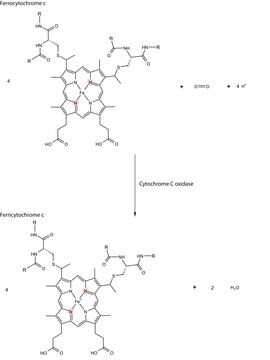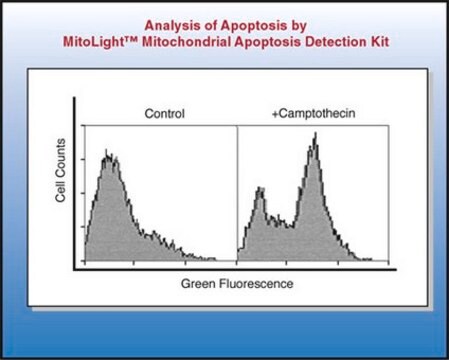CYTOCOX1
Cytochrome c Oxidase Assay Kit
sufficient for 100 tests, soluble and membrane bound mitochondria
Synonym(s):
Cytochrome c Oxidase Activity Assay Kit
About This Item
Recommended Products
Quality Level
usage
sufficient for 100 tests
shipped in
dry ice
storage temp.
−20°C
Gene Information
human ... COX1(4512)
Application
Biochem/physiol Actions
Features and Benefits
- Simple, optimized protocol - Obtain reproducible results without special training needs
- Useful for determining cytochrome c activity from any mitchondrial source - The enzyme is present in all mitochondria regardless of species
- Useful for detecting the presence of mitochondria in subcellular fraction - Save time and increase confidence in the quality of organelle preparations
- May be used in conjunction with the MITOISO1 Mitochondrial Isolation Kit - Standardized mitochondrial preparation and analysis ensures reproducibility
- Use to analyze the intactness of mitochondrial membranes
- Simple colorimetric measurement of solution
related product
Signal Word
Danger
Hazard Statements
Precautionary Statements
Hazard Classifications
Eye Dam. 1 - Skin Irrit. 2
Storage Class Code
10 - Combustible liquids
Regulatory Listings
Regulatory Listings are mainly provided for chemical products. Only limited information can be provided here for non-chemical products. No entry means none of the components are listed. It is the user’s obligation to ensure the safe and legal use of the product.
PDSCL
Please refer to KIT Component information
PRTR
Please refer to KIT Component information
FSL
Please refer to KIT Component information
ISHL Indicated Name
Please refer to KIT Component information
ISHL Notified Names
Please refer to KIT Component information
Cartagena Act
Please refer to KIT Component information
JAN Code
キットコンポーネントの情報を参照してください
Certificates of Analysis (COA)
Search for Certificates of Analysis (COA) by entering the products Lot/Batch Number. Lot and Batch Numbers can be found on a product’s label following the words ‘Lot’ or ‘Batch’.
Already Own This Product?
Find documentation for the products that you have recently purchased in the Document Library.
Customers Also Viewed
Articles
The isolation of subcellular fractions by centrifugation is a commonly used technique and is widely applicable across multiple cell and tissue types. Because organelles differ in their size, shape, and density, centrifugation can be easily employed to separate and purify organelle fractions from gently homogenized samples.
Learn about the four membrane-bound protein complexes that make up the electron transport chain metabolic pathway supplying energy as ATP for cellular respiration.
Cellular apoptosis assays to detect programmed cell death using Annexin V, Caspase and TUNEL DNA fragmentation assays.
Our team of scientists has experience in all areas of research including Life Science, Material Science, Chemical Synthesis, Chromatography, Analytical and many others.
Contact Technical Service







